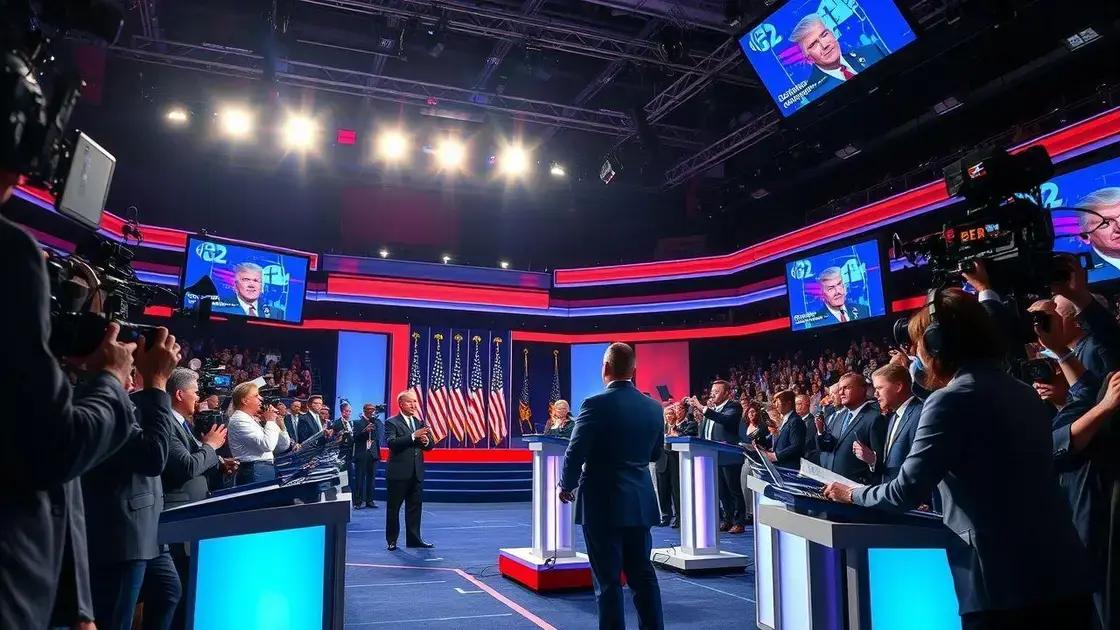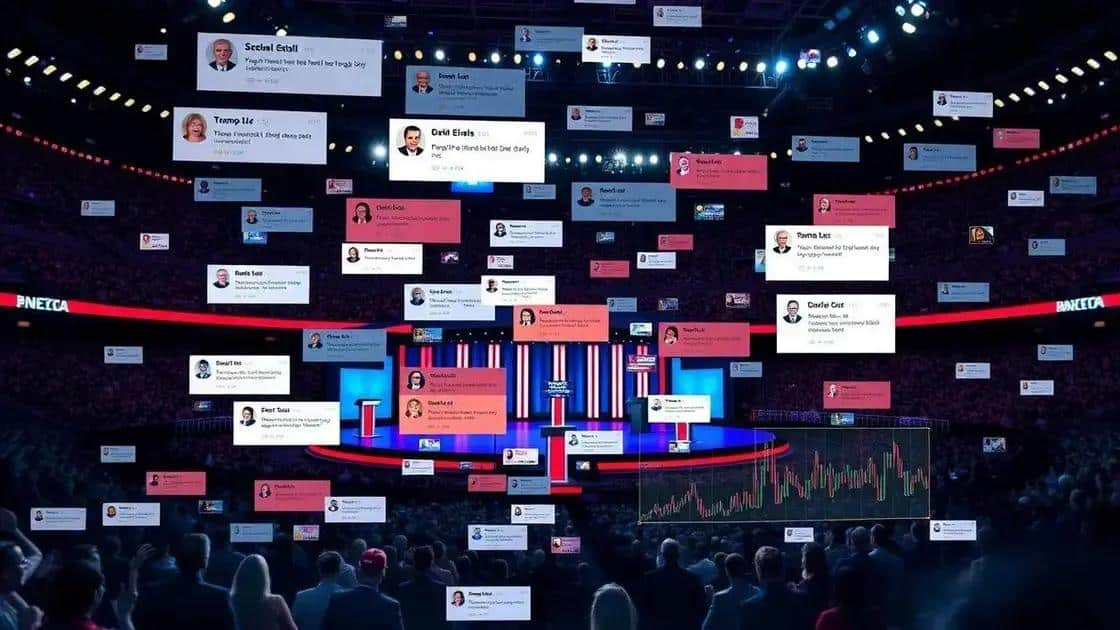Cultural presidential debate coverage: what you need to know

Cultural presidential debate coverage is increasingly shaped by technology and social media, which enhance engagement and ensure diverse perspectives are represented, making the debate process more interactive and meaningful for voters.
Cultural presidential debate coverage plays a vital role in shaping how the public perceives candidates and issues. It’s fascinating to see how various media outlets choose to highlight different aspects, influencing voter perception significantly. What does this mean for the average voter?
The significance of cultural coverage in debates
The significance of cultural coverage in debates cannot be overstated. It influences the way debates are perceived and discussed among the public. Cultural perspectives bring depth, showing how different communities interpret candidates’ messages based on their backgrounds.
Understanding Cultural Context
Cultural context shapes how messages are received. For example, a candidate’s mention of social issues can resonate differently among various demographic groups. This highlights the need for reporters to consider the cultural elements at play.
By integrating cultural narratives, media outlets create richer stories and encourage a broader discussion.
Media’s Role in Framing
The media plays a crucial role in framing debate narratives. Different outlets might focus on varied aspects, such as:
- Candidate performance and charisma
- Responses to social issues
- Fact-checking and misinformation
These choices affect public opinion, and therefore, understanding how cultural coverage works is essential.
Through cultural lenses, debates are not just about policies; they also reflect voters’ values and experiences. This dynamic can drive engagement and lead to a more informed electorate, making the debate process even more valuable.
How media shapes debate narratives
The way media shapes debate narratives is crucial to understanding public perception. Media outlets have the power to highlight specific issues, create engaging storylines, and influence how audiences interpret what they see and hear. This role is important in shaping opinions during elections.
Media Influence on Public Perception
Media greatly affects public perception by choosing which topics to cover and how to frame them. For instance, a debate segment focusing on a candidate’s stance on healthcare can send strong messages to voters about their priorities. This process of selection and framing helps to establish narratives around candidates.
Different outlets may interpret the same event in various ways, influencing each audience uniquely.
Types of Media Coverage
There are several types of media coverage that can shape the narratives of a debate:
- Live commentary that adds context in real-time
- Analysis pieces that dissect candidates’ performances
- Editorials that provide opinions on key moments
These elements can collectively guide how people view a debate, especially if some aspects are emphasized while others are downplayed.
Moreover, social media plays a growing role in shaping narratives. Tweets and posts can spread moments from debates, sometimes becoming highlights that overshadow the actual discussions. This modern form of coverage captures instant reactions and emotions, affecting the overall narrative more than traditional media alone.
Analyzing public response to debate coverage

Analyzing public response to debate coverage helps us understand voter sentiment and engagement. Social media and surveys provide a window into how audiences react to what they see during debates. This reaction is essential, as it can shape candidates’ strategies moving forward.
Engagement Metrics
Several engagement metrics can be used to measure public response:
- Number of social media interactions
- Comments and sentiments shared online
- Poll results immediately following the debate
These metrics reveal not just opinions but also the intensity of feelings regarding specific candidates or issues.
Impact of Opinion Polls
Opinion polls play a significant role in understanding public response. They often gauge how voters feel about each candidate’s performance. Following a debate, these polls can show shifts in support. This feedback can be a powerful tool for campaigns to adjust their messaging.
Furthermore, analyzing comments on social media provides insight into specific moments that resonated with viewers. For example, a strong rebuttal or a memorable quote can lead to increased support. This perspective helps candidates see where they successfully connected with the audience.
Overall, analyzing the public’s response to a debate can inform future tactics. Candidates can learn what messages work and which ones fall flat, allowing for more effective communication strategies in later debates.
The role of social media in debate discussions
The role of social media in debate discussions has transformed how we engage with political events. Platforms like Twitter, Facebook, and Instagram allow millions to voice their opinions instantly, creating a dynamic conversation around debates. This immediacy can amplify certain messages and shape public perception.
Real-Time Reactions
Social media provides real-time reactions during debates. Viewers can comment on candidates’ performances, share memes, and express their thoughts as the event unfolds. This live commentary captures the mood of the audience, reflecting how individuals interpret key moments.
For instance, a witty comeback by a candidate can lead to a flood of retweets, increasing its visibility. This creates a snowball effect where certain moments gain more traction in the public eye.
Influence on Voter Engagement
Social media also plays a critical role in voter engagement. It facilitates discussions that might not occur in traditional media settings. Many young voters, especially, turn to social media for information and analysis.
- Encouraging community discussions about policies
- Sharing informative content about candidates
- Mobilizing voters through calls to action
Moreover, hashtags related to debates can unify conversations, allowing individuals to connect over shared interests and opinions.
Overall, social media bridges the gap between candidates and voters, making political discourse more accessible. It reflects a shift in how discussions around debates are formed, leading to more interactive and engaged citizenry.
Future trends in cultural presidential debate coverage
Future trends in cultural presidential debate coverage are rapidly evolving with technology and audience expectations. The way we consume information continues to change, affecting how debates are presented and discussed.
Increased Use of Technology
As technology advances, we can expect to see more innovative ways to cover debates. Augmented reality (AR) and virtual reality (VR) may become common, providing immersive experiences that allow viewers to engage deeply with the content. This shift could make debates feel more personal and interactive.
Moreover, artificial intelligence could play a role in analyzing debate performances in real time, offering insights that enhance viewer understanding.
Focus on Diverse Voices
Another significant trend will likely be a greater emphasis on diverse perspectives in coverage. Media outlets are increasingly recognizing the importance of representing various communities and viewpoints. This could lead to:
- More inclusive guest commentators and analysts
- Coverage that prioritizes underrepresented voices
- Engagement with grassroots movements and organizations
By highlighting these perspectives, coverage can become richer and more representative of the electorate.
Additionally, the rise of social media influencers will further shape how debates are discussed. Influencers can bridge the gap between traditional media and younger audiences, encouraging active participation and dialogue about key issues.
Overall, embracing these trends will enhance the way cultural presidential debate coverage is produced and consumed, turning debates into more engaging and meaningful experiences for viewers.
FAQ – Frequently Asked Questions about Cultural Presidential Debate Coverage
How has technology changed debate coverage?
Technology now allows for augmented and virtual reality experiences, making debates more immersive and engaging for viewers.
Why is social media important during debates?
Social media enables real-time reactions, encourages public engagement, and amplifies different perspectives on candidates and issues.
What role do diverse voices play in debate discussions?
Diverse voices ensure that different viewpoints are represented, helping create a richer narrative around the debates.
How can future debate coverage enhance voter understanding?
By incorporating interactive formats and technology, future coverage can provide clearer insights into candidates’ positions and the implications of their policies.






